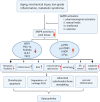AMPK: implications in osteoarthritis and therapeutic targets
- PMID: 33437352
- PMCID: PMC7791500
AMPK: implications in osteoarthritis and therapeutic targets
Abstract
Osteoarthritis (OA) is the most common skeletal disease and the leading cause of pain and disability in the aged population (>65 years). However, the underlying factors involved in OA pathogenesis remain elusive which has resulted in failure to identify disease-modifying OA drugs. Altered metabolism has been shown to be a prominent pathological change in OA. As a critical bioenergy sensor, AMP-activated protein kinase (AMPK) mediates not only energy homeostasis but also redox balance in chondrocytes to counter various cell stress. Dysfunction of AMPK activity has been associated with reduced autophagy, impaired mitochondrial function, excessive reactive oxygen species generation, and inflammation in joint tissue. These abnormalities ultimately trigger articular cartilage degeneration, synovial inflammation, and abnormal subchondral bone remodeling. This review focuses on recent findings describing the central role of AMPK in joint homeostasis and OA development. We also highlight current advances that target AMPK as a novel therapeutic strategy for OA prevention.
Keywords: AMPK; Osteoarthritis; autophagy; inflammation; metabolism.
AJTR Copyright © 2020.
Conflict of interest statement
None.
Figures


Similar articles
-
Inflammation and intracellular metabolism: new targets in OA.Osteoarthritis Cartilage. 2015 Nov;23(11):1835-42. doi: 10.1016/j.joca.2014.12.016. Osteoarthritis Cartilage. 2015. PMID: 26521729 Free PMC article. Review.
-
The Role of Mitochondrial Metabolism, AMPK-SIRT Mediated Pathway, LncRNA and MicroRNA in Osteoarthritis.Biomedicines. 2022 Jun 22;10(7):1477. doi: 10.3390/biomedicines10071477. Biomedicines. 2022. PMID: 35884782 Free PMC article. Review.
-
Cartilage degradation in osteoarthritis: A process of osteochondral remodeling resembles the endochondral ossification in growth plate?Med Hypotheses. 2018 Dec;121:183-187. doi: 10.1016/j.mehy.2018.08.023. Epub 2018 Aug 27. Med Hypotheses. 2018. PMID: 30396477
-
Chondrocyte Apoptosis in the Pathogenesis of Osteoarthritis.Int J Mol Sci. 2015 Oct 30;16(11):26035-54. doi: 10.3390/ijms161125943. Int J Mol Sci. 2015. PMID: 26528972 Free PMC article. Review.
-
Mitochondrial biogenesis is impaired in osteoarthritis chondrocytes but reversible via peroxisome proliferator-activated receptor γ coactivator 1α.Arthritis Rheumatol. 2015 May;67(8):2141-53. doi: 10.1002/art.39182. Arthritis Rheumatol. 2015. PMID: 25940958 Free PMC article.
Cited by
-
Knowledge mapping of autophagy in osteoarthritis from 2004 to 2022: A bibliometric analysis.Front Immunol. 2023 Mar 9;14:1063018. doi: 10.3389/fimmu.2023.1063018. eCollection 2023. Front Immunol. 2023. PMID: 36969240 Free PMC article.
-
Development of novel osteoarthritis therapy by targeting AMPK-β-catenin-Runx2 signaling.Genes Dis. 2024 Feb 24;12(1):101247. doi: 10.1016/j.gendis.2024.101247. eCollection 2025 Jan. Genes Dis. 2024. PMID: 39552787 Free PMC article. Review.
-
New insights into the interplay between autophagy and cartilage degeneration in osteoarthritis.Front Cell Dev Biol. 2022 Dec 5;10:1089668. doi: 10.3389/fcell.2022.1089668. eCollection 2022. Front Cell Dev Biol. 2022. PMID: 36544901 Free PMC article. Review.
-
The Metabolic Landscape in Osteoarthritis.Aging Dis. 2022 Jul 11;13(4):1166-1182. doi: 10.14336/AD.2021.1228. eCollection 2022 Jul 11. Aging Dis. 2022. PMID: 35855332 Free PMC article.
-
Endoplasmic reticulum stress-mediated apoptosis and autophagy in osteoarthritis: From molecular mechanisms to therapeutic applications.Cell Stress Chaperones. 2024 Dec;29(6):805-830. doi: 10.1016/j.cstres.2024.11.005. Epub 2024 Nov 19. Cell Stress Chaperones. 2024. PMID: 39571722 Free PMC article. Review.
References
-
- GBD 2015 Disease and Injury Incidence and Prevalence Collaborators. Global, regional, and national incidence, prevalence, and years lived with disability for 310 diseases and injuries, 1990-2015: a systematic analysis for the Global Burden of Disease Study 2015. Lancet. 2016;388:1545–1602. - PMC - PubMed
-
- Sherwood J. Osteoarthritis year in review 2018: biology. Osteoarthritis Cartilage. 2019;27:365–370. - PubMed
-
- Francisco V, Perez T, Pino J, Lopez V, Franco E, Alonso A, Gonzalez-Gay MA, Mera A, Lago F, Gomez R, Gualillo O. Biomechanics, obesity, and osteoarthritis. The role of adipokines: when the levee breaks. J Orthop Res. 2018;36:594–604. - PubMed
-
- Salminen A, Kaarniranta K. AMP-activated protein kinase (AMPK) controls the aging process via an integrated signaling network. Ageing Res Rev. 2012;11:230–241. - PubMed
Publication types
LinkOut - more resources
Full Text Sources
Research Materials
